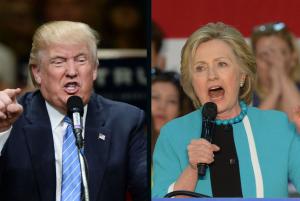Tuesday’s the big day. There are warnings that White Supremacists will try to intimidate minority voters. Then, there are fears that Russia will find ways to disrupt things (such as shutting down the electrical grid, or the Internet). Al Qaeda and ISIS have also suggested that they may bomb American cities. There are all kinds of worries, but let’s try to ignore all that. Let’s look at election night, itself.
Karl Rove gave his opinion of what to watch for in the Wall Street Journal.
While votes are still being cast, the TV networks will comment on exit polls, though they won’t reveal what the surveys show about the head-to-head matchup. The exits can be spectacularly wrong—they predicted a John Kerry victory in 2004. . .
Two things to look for in the exits: First, how is Mr. Trump doing among white voters? His strategy requires grabbing a higher percentage of whites than Mitt Romney’s 59% and boosting their share of the turnout above 2012’s 72%. College-educated whites traditionally vote Republican, but Mr. Trump has struggled with them. Will he match Mr. Romney’s 51% among all college grads?
Second, how is Mrs. Clinton doing among minorities and millennials? Her strategy calls for replicating President Obama’s 2012 coalition. That year African-Americans were 13% of turnout, and 93% went for Mr. Obama; Hispanics were 10% of turnout, and 71% voted for him; and millennials were 19% of turnout, 60% of whom supported the president.
Actual votes will be reported beginning at 6 p.m., Eastern Standard Time, when polls in parts of Indiana and Kentucky close. . . Watch for how each party’s vote has shifted since 2012. Although Mr. Trump is likely to win Indiana and Kentucky, comparing his margin to Mr. Romney’s might indicate what’s happening nationally.
These early results could provide important clues about the election’s direction. Watch for how each party’s vote has shifted since 2012. . .
The second clue will be changes in turnout. Is it larger or smaller than 2012? What about in counties with high percentages of African-Americans, Latinos, millennials and educated whites? These trends will be especially important in the four swing states that report early.
Florida is this election’s most important battleground. Democrats have carried 18 states and the District of Columbia in all of the past six presidential contests. If Mrs. Clinton wins the 242 electoral votes from this “Blue Wall,” she needs only Florida’s 29 to take the White House. Mr. Trump must win Florida to keep open his path to the presidency. . .
Ohio, with 18 electoral votes, is this year’s second-most important state. No Republican has ever won the White House without the Buckeye State. . . The next most important states are North Carolina and Virginia, with a combined 28 electoral votes.
Meanwhile, NBC also offered a “tick-tock” time-release viewer’s guide.
DURING THE DAY: All about turnout
Yes, there is no greater cliché in American politics than the solemn pronouncement that the results of an election “will all come down to turnout.” But just because it’s all-too-familiar doesn’t mean it’s not mostly true. . .
Long lines in diverse and highly-educated areas of key swing states (think Miami, Charlotte and the Philadelphia and Atlanta suburbs) would be generally good signs for Clinton. Reports of crowds in whiter, more blue-collar areas (the Rust Belt) could be a sign that Trump is mobilizing more of his own base.
5 p.m. ET: Exit polls. . .The exit polls provide the most complete picture of voter attitudes on Election Day. . .
7 p.m. ET: The first results: Now it gets really interesting! Six states have a FINAL poll close at 7 p.m.: Georgia, Indiana, Kentucky, South Carolina, Vermont and Virginia. Here are some key things to watch:
Positive early numbers in Virginia would be a great sign for Hillary Clinton. . . For a good early indicator of how the Trump effect may be factoring into down-ballot races, keep an eye on VA-10. . . Georgia. . .Look at how big minority turnout here was, and keep an eye on county results in Atlanta’s affluent suburbs, where Trump could have turned off the high education white voters. . .
7:30 p.m. ET: Two biggies: North Carolina and Ohio: In the Tarheel State, keep an eye on population centers around Raleigh and Charlotte. . . Ohio’s relatively low share of college-educated white voters could make it a ripe pickup for Trump. Watch Clinton’s margins in key swing areas like Hamilton County. . .
8 p.m. ET: Florida, and more Clinton firewall states: More than a dozen states have final poll closings now, but here are the most important ones: Florida, New Hampshire and Pennsylvania. . . Florida’s famed I-4 corridor. . . Philadelphia suburbs — places like Bucks and Chester Counties. . .
9 p.m. ET: Watch the Rust Belt — and demographics are destiny in Arizona? If Clinton is headed towards a historic sweep, we’ll have a better idea of how big it is once we hit the 9 p.m. poll closings. If Trump is going to take things down to the wire, we’ll know by watching the Rust Belt, too. . .
Wisconsin and Michigan. . .Trump will almost certainly have to flip one of these blue states red to get to 270 electoral votes. . . Colorado. . .Watch whether Latino turnout approaches 2008 and 2012 levels early, and keep an eye on the split among younger voters.
10 p.m. ET: Suspense in… Utah? . . . if Evan McMullin bests Trump and Clinton in Utah, he would be the first third party candidate to win a state since 1968. . . Iowa, which could be Trump’s best swing state of the bunch.
11 p.m. ET: Lights out in every state but Alaska: The five states that close at 11 p.m. ET — California, Hawaii, Idaho, Oregon and Washington — are all solid Republican or Democratic states. . .
